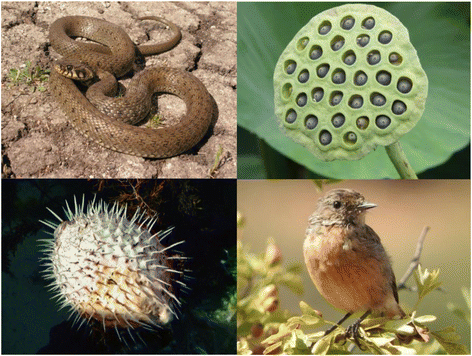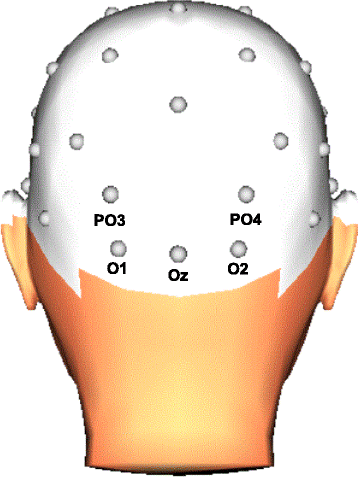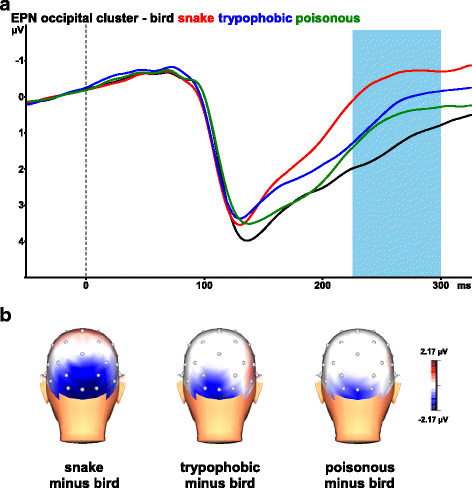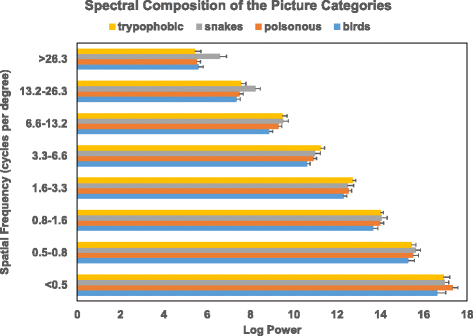Enhanced early visual processing in response to snake and trypophobic stimuli
- PMID: 29720255
- PMCID: PMC5930515
- DOI: 10.1186/s40359-018-0235-2
Enhanced early visual processing in response to snake and trypophobic stimuli
Abstract
Background: Trypophobia refers to aversion to clusters of holes. We investigated whether trypophobic stimuli evoke augmented early posterior negativity (EPN).
Methods: Twenty-four participants filled out a trypophobia questionnaire and watched the random rapid serial presentation of 450 trypophobic pictures, 450 pictures of poisonous animals, 450 pictures of snakes, and 450 pictures of small birds (1800 pictures in total, at a rate of 3 pictures/s). The EPN was scored as the mean activity at occipital electrodes (PO3, O1, Oz, PO4, O2) in the 225-300 ms time window after picture onset.
Results: The EPN was significantly larger for snake pictures than for the other categories, and significantly larger for trypophobic pictures and poisonous animal pictures than for bird pictures. Remarkably, the scores on the trypophobia questionnaire were correlated with the EPN amplitudes for trypophobic pictures at the occipital cluster (r = -.46, p = .025).
Conclusions: The outcome for the EPN indicates that snakes, and to a somewhat lesser extent trypophobic stimuli and poisonous animals, trigger early automatic visual attention. This supports the notion that the aversion that is induced by trypophobic stimuli reflects ancestral threat and has survival value. The possible influence of the spectral composition of snake and trypophobic stimuli on the EPN is discussed.
Keywords: EEG/ERP, early posterior negativity (EPN); Evolution; Phylogenetic fear; Snake detection; Trypophobia.
Conflict of interest statement
Ethics approval and consent to participate
The study was conducted in accordance with the Declaration of Helsinki. Participants gave written informed consent to participate in the study. The research was approved by the Local Ethics Committee of the Department of Psychology, Education and Child Studies of the Erasmus University Rotterdam.
Competing interests
The authors declare that they have no competing interests.
Publisher’s Note
Springer Nature remains neutral with regard to jurisdictional claims in published maps and institutional affiliations.
Figures




Similar articles
-
Blurring attenuates the early posterior negativity in response to snake stimuli.Int J Psychophysiol. 2019 Dec;146:201-207. doi: 10.1016/j.ijpsycho.2019.09.002. Epub 2019 Oct 25. Int J Psychophysiol. 2019. PMID: 31669318
-
Testing the snake-detection hypothesis: larger early posterior negativity in humans to pictures of snakes than to pictures of other reptiles, spiders and slugs.Front Hum Neurosci. 2014 Sep 4;8:691. doi: 10.3389/fnhum.2014.00691. eCollection 2014. Front Hum Neurosci. 2014. PMID: 25237303 Free PMC article.
-
Curvilinear shapes and the snake detection hypothesis: An ERP study.Psychophysiology. 2016 Feb;53(2):252-7. doi: 10.1111/psyp.12564. Epub 2015 Oct 20. Psychophysiology. 2016. PMID: 26481589
-
Both low and high spatial frequencies drive the early posterior negativity in response to snake stimuli.Neuropsychologia. 2022 Dec 15;177:108403. doi: 10.1016/j.neuropsychologia.2022.108403. Epub 2022 Nov 1. Neuropsychologia. 2022. PMID: 36332696
-
Are Humans Prepared to Detect, Fear, and Avoid Snakes? The Mismatch Between Laboratory and Ecological Evidence.Front Psychol. 2019 Sep 11;10:2094. doi: 10.3389/fpsyg.2019.02094. eCollection 2019. Front Psychol. 2019. PMID: 31572273 Free PMC article. Review.
Cited by
-
Excessive fear of clusters of holes, its interaction with stressful life events and the association with anxiety and depressive symptoms: large epidemiological study of young people in Hong Kong.BJPsych Open. 2023 Aug 14;9(5):e151. doi: 10.1192/bjo.2023.540. BJPsych Open. 2023. PMID: 37577835 Free PMC article.
-
[Neural mechanisms of fear responses to emotional stimuli: a preliminary study combining early posterior negativity and electroencephalogram source network analysis].Sheng Wu Yi Xue Gong Cheng Xue Za Zhi. 2024 Oct 25;41(5):951-957. doi: 10.7507/1001-5515.202403052. Sheng Wu Yi Xue Gong Cheng Xue Za Zhi. 2024. PMID: 39462663 Free PMC article. Chinese.
-
Emotion-Attention Interaction in the Right Hemisphere.Brain Sci. 2021 Jul 29;11(8):1006. doi: 10.3390/brainsci11081006. Brain Sci. 2021. PMID: 34439624 Free PMC article. Review.
-
A social media network analysis of trypophobia communication.Sci Rep. 2022 Dec 7;12(1):21163. doi: 10.1038/s41598-022-25301-3. Sci Rep. 2022. PMID: 36477698 Free PMC article.
References
MeSH terms
Supplementary concepts
LinkOut - more resources
Full Text Sources
Other Literature Sources
Medical

